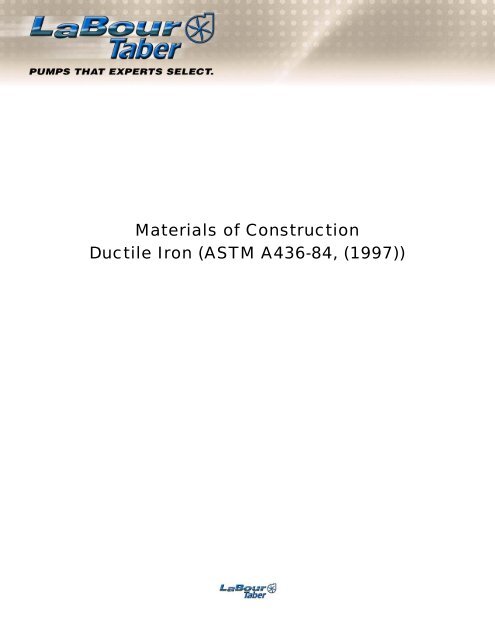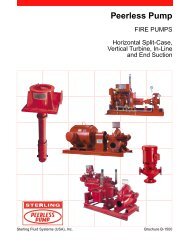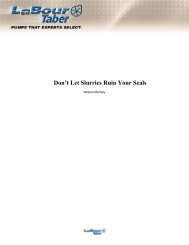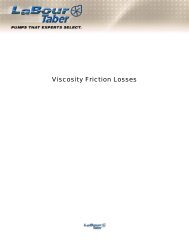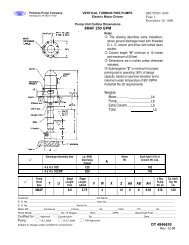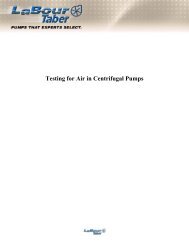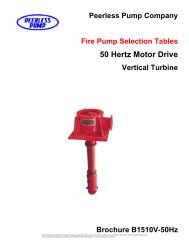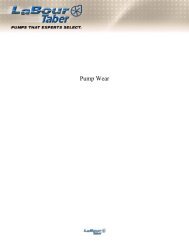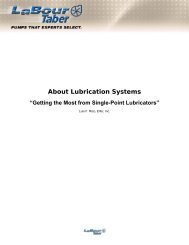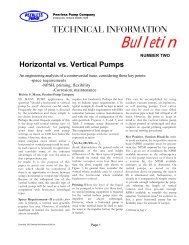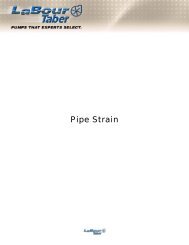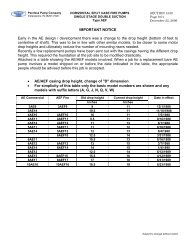Materials of Construction Ductile Iron (ASTM A436 ... - Peerless Pump
Materials of Construction Ductile Iron (ASTM A436 ... - Peerless Pump
Materials of Construction Ductile Iron (ASTM A436 ... - Peerless Pump
Create successful ePaper yourself
Turn your PDF publications into a flip-book with our unique Google optimized e-Paper software.
<strong>Materials</strong> <strong>of</strong> <strong>Construction</strong><strong>Ductile</strong> <strong>Iron</strong> (<strong>ASTM</strong> <strong>A436</strong>-84, (1997))
Because <strong>Ductile</strong> <strong>Iron</strong> has so many properties comparable to cast steel, its use inpumps in the chemical process, petro-chemical and petroleum refining fields hasbeen well accepted.LaBour <strong>Pump</strong> has highly specialized methods <strong>of</strong> production and quality control forductile iron, which has proved to be an outstanding material for the <strong>Peerless</strong>Model 8196 as well as the LaBour Model LVA process pump.The basic difference between steel and cast iron is the amount and nature <strong>of</strong> thecontained carbon. Steels contain carbon in the range <strong>of</strong> 0.12% to 1.70%, and thecarbon present may be in the free state as fine spheroidal graphite, mixed inlayers consisting <strong>of</strong> iron and iron carbide (pearlite), or as free iron carbide(cementite). Generally cast iron contains carbon from 3.0% to 3.7% that ispredominantly present as flakes <strong>of</strong> graphite. There also exists pearlite and somecementite. The presence <strong>of</strong> graphite flakes act to break up the continuity <strong>of</strong> themetal matrix, causing, in effect, a series <strong>of</strong> notches that act as stressconcentrators, thereby causing brittleness and low strength. If these flakes <strong>of</strong>graphite could be made to occupy less space and conform to a definite pattern,the metal matrix would have good continuity and the iron would exhibit strengthand toughness comparable to steel.A cast iron which has a tensile strength <strong>of</strong> 25,000 PSI to 35,000 PSI can beconverted to an iron <strong>of</strong> 60,000 PSI to 100,000 PSI tensile strength and have agood measure <strong>of</strong> toughness and ductility by proper treatment with magnesiumand silicon alloys. These alloys convert the flake graphite to spheroidal graphite.Since a spheriodal shapte presents a minimum surface for a given volume, itproduces the least area, and a far tougher and ductile material. This resultingstructure is similar to steel and so are its physical properties. This iron is <strong>Ductile</strong><strong>Iron</strong> and is also known as Nodular <strong>Iron</strong>, S G <strong>Iron</strong> and Graphitic Steel.The chemistry <strong>of</strong> <strong>Ductile</strong> <strong>Iron</strong> and cast iron is similar. Precautions however aretaken to minimize the impurities such as phosphorous and sulphur and to controlthe amount <strong>of</strong> magnesium and silicon present to get the desired physicalproperties.Quality ControlQuality control <strong>of</strong> <strong>Ductile</strong> <strong>Iron</strong> is needed to assure the proper base chemistry. Ourprocedures list the raw feed material to be only pig iron, structural steel scrap,and ductile returns. The quality <strong>of</strong> <strong>Ductile</strong> <strong>Iron</strong> is checked by various means.At least two standard keel block test blocks are cast from each pour. Castingsand keel blocks are then heat treated and checked in the following manner:
1. A Spectrograph is utilized to confirm the chemical analysis.2. Test bars are machined for physical tests. These bars are subjected toloads to determine the yield strength, and the tensile strength.3. A test piece is cut for a microscopic analysis.4. Spot tests, such as fracture test and oxy-acetylene torch cuts areperformed on gates and risers <strong>of</strong> castings as an additional check thatLaBour <strong>Ductile</strong> <strong>Iron</strong> meets specifications.5. All castings poured in each heat are identified by cast-on heat numbers andthe “DI” symbol. No castings are released from the foundry until the metalquality is confirmed.Duplicate records are kept in the Metallurgical Office, identifying each castingpour by pattern number, heat number, order number, along with chemical,physical and photo-micrographic analysis. If the customer so desires, test pieces,which have been heat treated with his castings, will be sent to him with ordernumber and heat number cast on.Should the customer want a test piece, this has to be stated on the original orderat the time <strong>of</strong> order placement. These items are not available after the casting ispoured.LaBour Types <strong>of</strong> Cast <strong>Iron</strong>The LaBour standard type <strong>of</strong> <strong>Ductile</strong> <strong>Iron</strong> is <strong>ASTM</strong> A-395-98, “StandardSpecification for Ferritic <strong>Ductile</strong> <strong>Iron</strong> Pressure-Retaining Castings for Use atElevated Temperatures”, 60-40-18, (60,000 PSI minimum tensile strength, 40,000PSI minimum yield strength- 18% minimum elongation. The specification, <strong>ASTM</strong>536-84 (re-approved 1993), “Standard Specification for <strong>Ductile</strong> <strong>Iron</strong>”, is the mostcommonly used standard and has five grades (60-40-18, 65-45-12, 80-55-06,100-70-03, and 120-90-02)LaBour will also make 60-45-10 and 80-60-03 if required. Type 80-60-03 has anessentially pearlite structure. The structure <strong>of</strong> 60-45-10 and 60-45-15, however, ismainly ferritic. Type 60-45-15 is fully annealed ferritic <strong>Ductile</strong> <strong>Iron</strong> having thegreatest ductility <strong>of</strong> the three types. This makes it the best shock resistant type.Ferritic <strong>Ductile</strong> <strong>Iron</strong> can be heated up to temperatures above 1300 deg F andhosed down (quenched) with cold water without cracking.<strong>Ductile</strong> <strong>Iron</strong> vs. Cast Steel
Navy explosion tests show <strong>Ductile</strong> <strong>Iron</strong> type 60-45-15 comparable in shockresistance to the ordinary grades <strong>of</strong> mild carbon steel. Because <strong>of</strong> its toughness,this type is permitted by the Navy for shipboard applications.Broadly speaking types 60-45-10 and 80-60-03 have high temperature strengthroughly comparable to that <strong>of</strong> ordinary cast steel up to 800 deg F. The yieldstrength <strong>of</strong> 60-45-15 is superior to cast low carbon steel at all temperatures up to1200 deg F.The fluidity <strong>of</strong> <strong>Ductile</strong> <strong>Iron</strong> makes it capable <strong>of</strong> being cast into small or largecastings with light or heavy sections or intricate shapes that are difficult to castin most steel. Castings <strong>of</strong> <strong>Ductile</strong> <strong>Iron</strong> varying from fractions <strong>of</strong> an ounce to over50 tons and with sections from 1/8 inch to 50 inch in thickness have been castsuccessfully.Corrosion ResistanceThe following data was resultant with ductile iron that was inoculated using theInternational Nickel Company methods using a nickel based magnesium alloy,similar to a Ni-Resist material.International Nickel Company, Inc., tested various types <strong>of</strong> iron in a 5% by weightair saturated sulphuric acid solution at 86 deg F for 24 hours. The results suggestthat when there is a to be an exposure to acidic solution, <strong>Ductile</strong> <strong>Iron</strong> can beexpected to perform better than gray cast iron and the greatest improvement willbe achieved when the <strong>Ductile</strong> <strong>Iron</strong> is annealed to provide a ferritic matrix. Testshave also proven that <strong>Ductile</strong> <strong>Iron</strong> resists atmospheric corrosion better than mostcarbon steels.The vast majority <strong>of</strong> ductile iron that is produced is inoculated using a ferrosiliconbased magnesium alloySummary<strong>Ductile</strong> <strong>Iron</strong>’s high strength and toughness has allowed the engineer to design foreconomy as well as for performance. <strong>Ductile</strong> <strong>Iron</strong> should be considered in anyapplication where cast steel has previously been required.LaBour <strong>Pump</strong> Company – 901 Ravenwood Drive, Selma, Alabama 36701Ph: (317) 924-7384 - Fax: (317) 920-6605 - www.labourtaber.comA Product <strong>of</strong> <strong>Peerless</strong> <strong>Pump</strong> CompanyCopyright © 2005 <strong>Peerless</strong> <strong>Pump</strong> Company


